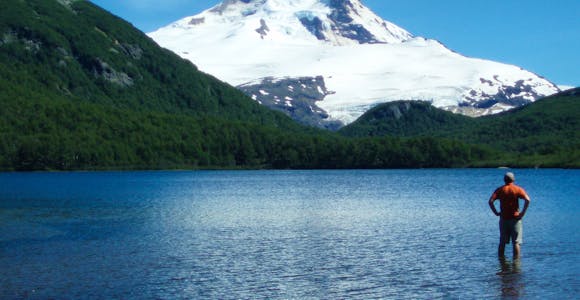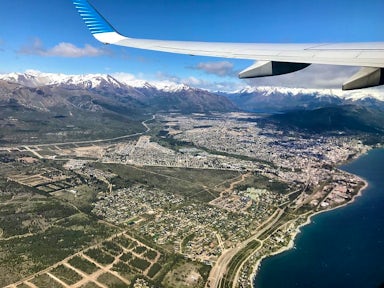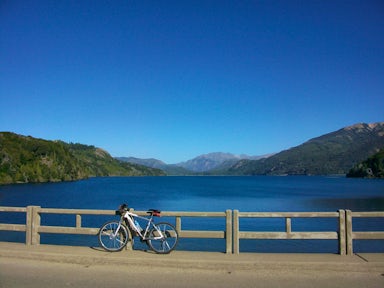
Bariloche
On the shores of the vast, blue Lake Nahuel Huapi, the alpine town of Bariloche is surrounded by forests, mountains, and lakes in the heart of the Argentine Lake District.
Discover MoreDeep roots in Patagonia: We are ex-guides, tour leaders, outdoor enthusiasts, & adventurers.
We’ve got our feet on the ground: Impartial advice, a bespoke service, and at no extra cost.
For the ends of the Earth: Sustainability is more than our carbon footprint (but we’re reducing that too).
Deep roots in Patagonia: We are ex-guides, tour leaders, outdoor enthusiasts, & adventurers.
We’ve got our feet on the ground: Impartial advice, a bespoke service, and at no extra cost.
For the ends of the Earth: Sustainability is more than our carbon footprint (but we’re reducing that too).

The Argentine Lake District is easy to integrate into a trip to other parts of the region, whether you're coming direct from Buenos Aires, from Los Glaciares National Park in southern Patagonia or even coming across the border from Chile. This page will tell you how to get to and around the lakes.

View of Bariloche from the air
The Argentine Lake District is served by two main airports at Bariloche and San Martín de los Andes.
San Carlos de Bariloche Airport (BRC) is the main hub for the region. It has up to 15 daily flights to Buenos Aires (two hours). The majority go to the domestic hub of Aeroparque Jorge Newbery (AEP),with a small number of flights to Ezeiza International Airport (EZE) for international connections.
During the high season months of December to February there are three flights a week from Bariloche to El Calafate (FTE), taking 1¾hrs to connect the Lake District to Los Glaciares National Park. There are no direct flights from Bariloche to Ushuaia or Peninsula Valdés, but for northern Argentina there are seasonal connections to Mendoza (MDZ), Salta (SLA) and Rosario (ROS).
San Martín's Chapelco Airport (CPC) is less busy, but there are up to four flights a week to Buenos Aires (EZE), taking around two hours.

Road trip through Argentina's Lake District
Argentina is big, but it's still possible to get to the Lake District by road. Buses take an epic 22 hours to reach either Bariloche or San Martín from Buenos Aires. You can opt for either semi-cama (reclining seat) or cama (sleeper), but not that the road route is not significantly cheaper than a domestic flight.
The only way to reach the Lake District from Peninsula Valdés is by road. Overnight buses take around 15 hours from the gateway town of Puerto Madryn – a long trip but an oddly hypnotic one as you pass through the steppe looking out for guanacos and rheas. The final approach to Bariloche through the Andean foothills is spectacular.
To the south, Esquel (for Los Alerces National Park) is 485km from Bariloche, or just under 4½ hours drive. The north, Neuquen (for Argentina's wine country) is 438km (5hrs) from Bariloche and an almost identical distance from San Martín.

Ferry across Lake Nahuel Huapi on the Cruce Andino cross-border route
Several options exist to travel between the Argentine and Chilean Lake Districts, of which the most interesting by far is the scenic Cruce Andino route (also called the Cruce de Lagos), which combines ferries and buses to travel in around 12 hours between Bariloche and Puerto Varas.
An early morning shuttle bus takes you from Bariloche to Puerto Pañuelo, from where you catch a ferry along the western finger of Lake Nahuel Huapi to Puerto Blest. A bus then takes you a short ride to another ferry on Lake Frías, with great views of Cerro Tronador to the Chilean border at Puerto Frías, and on to Peulla on the shores of Lake Todos los Santos in Vicente Pérez National Park. A final boat trip, under the gaze of the Puntaguido and Osorno Volcanoes takes you to Petrohué, from where it's a short ride to Puerto Varas. The scenery on this trip is never less than breathtaking.
An alternative (if less organised) lake-and-road route runs between San Martín and Pucón in the north of the Chilean District. From San Martín, buses run to the border at Hua Hum Pas and on to Pirihuelco, from where you can take a ferry along Lake Pirihuelco to Puerto Fuy, and then a bus on to Pucón. The trip takes a full day.
There are also direct buses between Bariloche and Puerto Varas (7 hours) and between San Martín and Pucón (5 hours).
Want to know more about what it's like taking the Cruce Andino?
Swoop Patagonia Expert
Railway lovers looking for something different can take the overnight Tren Patagonico sleeper than runs weekly from Viedma in Río Negro across the steppe to Bariloche. The train departs Viedma every Friday, and Bariloche every Sunday.

Picnic stop whilst biking the Circuito Chico, Bariloche
Argentina's Lake District is large by easy to get around. The road that links Bariloche to San Martín de los Andes can be driven in a long day but given that it's one of the most scenic roads in the country (with half of it through a national park) it would a shame not to linger. The first half of the trip, from Bariloche to Villa la Angostura hugs the shore of Lake Nahuel Huapi. It's a beautiful setting, but one that almost pales in comparison with the stretch to San Martín – the famous Route of the Seven Lakes, that winds its way through a series of fantastical mountain and lakeside views.

On the shores of the vast, blue Lake Nahuel Huapi, the alpine town of Bariloche is surrounded by forests, mountains, and lakes in the heart of the Argentine Lake District.
Discover More
San Martín is a great base for exploring the Argentine Lake District, hiking Lanín Volcano or planning a cross-border trip into Chile.
Discover More
Nahuel Huapi National Park is the Argentina's most popular national park, thanks to its amazing landscpaes and proximity to the lakeside tourist hub of Bariloche.
Discover More
Wild and rugged and overlooked by the snowy peak of a dormant volcano, Lanín National Park offers some of the best hiking in the Argentine Lake District.
Discover MoreWe'll spend some time listening to your aspirations, then discuss the kind of experience that might suit you.
Next we'll discuss the options, shortlist the best trips for you and present you our impartial recommendations.
We'll place a 24 hour hold on your preferred option - without obligation - whilst we talk through the details.
Whatever your budget, group size, length of stay, preferred activity or appetite for adventure, we can help.
1-888-970-4571This website uses cookies to ensure you get the best experience on our website. Privacy policy